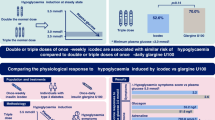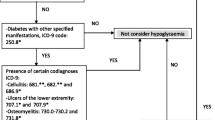Abstract
Objective
To compare the clinical characteristics and time course of severe hypoglycaemia (SH) on glimepiride and the reference drug glibenclamide.
Methods
SH was defined as a symptomatic event requiring administration of i.v. glucose or of glucagon. Four hundred doctors working in acute care hospitals were randomly selected from the membership directory of the German Diabetes Association and sent a standardised questionnaire about sulphonylurea-induced SH that occurred between June 2001 and August 2002. Detailed data on history, medication, laboratory parameters, treatment and time course of the SH were analysed.
Results
Altogether, 93 episodes of SH were registered, 37 on glimepiride and 56 on glibenclamide. The characteristics of the glimepiride- versus glibenclamide-induced SH were as follows: initial blood glucose 1.9±0.66 mmol/l versus 1.8±0.89 mmol/l, P=0.17; age 77±11.2 years versus 78±9.6 years, P=0.35; HbA1c 5.4±0.7% versus 5.2±0.9%, P=0.18; creatinine clearance 38±23 ml/min versus 54±32 ml/min, P=0.005; co-medication 6.2.±3 versus 3.6±3 preparations, P< 0.0001. Even very low doses of glimepiride (0.5 mg) and glibenclamide (0.88 mg) were associated with SH. Prolonged hypoglycaemia requiring more than 12 h i.v. glucose administration occurred in 8 of 37 of the glimepiride-treated subjects and 5 of 56 of those on glibenclamide. Prolonged hypoglycaemia necessitated infusion of 308±256 g (104–862 g) i.v. glucose over 43±16 h (24–64 h) in glimepiride-treated patients compared with 168±98 g (66–300 g) over 33±28 h (14–80 h) in glibenclamide-treated patients. Impaired renal function was present in 11 of 13 of all patients with prolonged hypoglycaemia and impaired liver function in 1 of 13.
Conclusion
In glimepiride- and glibenclamide-treated individuals with SH, no essential differences in the clinical characteristics or time course were shown; prolonged courses also occurred on glimepiride. Even in patients with only mild renal failure both preparations should be used with caution.





Similar content being viewed by others
References
Asplund K, Wiholm B-E, Lithner F (1983) Glibenclamide-associated hypoglycaemia: a report on 57 cases. Diabetologia 24:412–417
Holstein A, Plaschke A, Egberts E-H (2001) Lower incidence of severe hypoglycaemia in Type 2 diabetic patients treated with glimepiride versus glibenclamide. Diabetes Metab Res Rev 17:467–473
Ben-Ami H, Nagachandran P, Mendelson A, Edoute Y (1999) Drug-induced hypoglycemic coma in 102 diabetic patients. Arch Intern Med 159:281–284
Stahl M, Berger W (1999) Higher incidence of severe hypoglycaemia leading to hospital admission in type 2 diabetic patients treated with long-acting versus short-acting sulphonylureas. Diabetes Med 16:586–590
Sugarman JR (1991) Hypoglycemia associated hospitalizations in a population with a high prevalence of non-insulin-dependent diabetes mellitus. Diabetes Res Clin Pract 14:139–148
Bachmann W, Löbe A, Lacher F (1995) Medikamentös bedingte Hypoglykämien bei Typ-II-Diabetes. Diabetes und Stoffwechsel 4:83–89
Rydberg T, Wählin-Boll E, Melander A (1991) Determination of glibenclamide and its two major metabolites in human serum and urine by column liquid chromatography. J Chromatogr 564:223–233
Balant L, Zahnd GR, Weber F, Fabre J (1977) Behaviour of glibenclamide on repeated administration to diabetic patients. Eur J Clin Pharmacol 11:19–25
Hellman B, Schlin J, Täljedal IB (1984) Glibenclamide is exceptional among in hypoglycaemic sulphonylureas in accumulating progressively in β-cell-rich islets. Acta Endocrinol 105:385–390
Rydberg T, Jönsson A, Roder M, Melander A (1994) Hypoglycemic activity of glyburide (glibenclamide) metabolites in humans. Diabetes Care 17:1026–1030
Alexander RW (1966) Prolonged hypoglycemia following acetohexamide administration. Report on two cases with impaired renal function. Diabetes 15:362–364
Sonnenblick M, Shilo S (1986) Glibenclamide induced prolonged hypoglycaemia. Age Ageing 15:185–189
Sills MN, Ogu CC, Maxa J (1997) Prolonged hypoglycemic crisis associated with glyburide. Pharmacotherapy 17:1338–1340
Krepinsky J, Ingram AJ, Clase CM (2000) Prolonged sulfonylurea-induced hypoglycemia in diabetic patients with end-stage renal disease. Am J Kidney Dis 35:500–505
Müller G, Hartz D, Pünter J, Ökonomopulos R, Kramer W (1994) Differential interaction of glimepiride and glibenclamide with the β-cell-sulfonylurea receptor. I. Binding characteristics. Biochim Biophys Acta 1191:267–277
Kramer W, Müller G, Geisen K (1996) Characterization of the molecular mode of action of the sulfonylurea, glimepiride, at β-cells. Horm Metab Res 28:464–468
DCCT Research Group (1991) Epidemiology of severe hypoglycaemia in the Diabetic Control and Complication Trial. Am J Med 90:450–459
Cockroft DW, Gault MH (1976) Prediction of creatinine clearance from serum creatinine. Nephron 16:31–41
Joost H-G, Mengel K (2002) Antidiabetika. In: Schwabe U, Paffrath D (eds) Arzneiverordnungs-Report 2001. Springer, Berlin Heidelberg New York, pp 163–177
Song DK, Ashcroft FM (2001) Glimepiride block of cloned beta-cell, cardiac and smooth muscle K (ATP) channels. Br J Pharmacol 133:193–199
Draeger KE, Wernicke-Panten K, Lomp, H-J, Schuler E, Roßkamp R (1996) Long-term treatment of type 2 diabetic patients with the new oral antidiabetic agent glimepiride (Amaryl): a double-blind comparison with glibenclamide. Horm Metab Res 28:419–425
Dills DG, Schneider J, The Glimepiride/Glyburide Research Group (1996) Clinical evaluation of glimepiride versus glyburide in NIDDM in a double-blind comparative study. Horm Metab Res 28:426–429
Raptis SA, Hatziagelaki E, Dimitriadis G, Draeger KE, Pfeiffer C, Raptis AE (1999) Comparative effects of glimepiride and glibenclamide on blood glucose, C-peptide and insulin concentrations in the fasting and postprandial state in normal man. Exp Clin Endocrinol Diabetes 107:350–355
Müller G, Satoh Y, Geisen K (1995) Extrapancreatic effects of sulfonylureas—a comparison between glimepiride and conventional sulfonylureas. Diabetes Res Clin Pract 28[Suppl]:S115–S137
Haupt A, Kausch C, Dahl D, Bachmann O, Stumvoll M, Häring H, Matthaei S (2002) Effect of glimepiride on insulin-stimulated glucogen synthesis in cultured human skeletal muscle cells: a comparison to glibenclamide. Diabetes Care 25:2129–2132
Rosenkranz B, Profozic V, Metelko Z, Mrzljak V, Lange C, Malerczyk V (1996) Pharmacokinetics and safety of glimepiride at clinically doses in diabetic patients with renal impairment. Diabetologia 39:1617–1624
Badian M, Korn A, Lehr K-H, Malerczyk V, Waldhäusl W (1996) Pharmacokinetics and pharmacodynamics of the hydroxy-metabolite of glimepiride (Amaryl) after intravenous administration. Drug Metabol Drug Interact 13:69–85
Krentz AJ, Ferner RE, Bailey CJ (1994) Comparative tolerability profiles of oral antidiabetic agents. Drug Saf 11:223–241
Köhler GI, Bode-Böger SM, Busse R, Hoopmann M, Welte T, Böger RH (2000) Drug–drug interactions in elderly patients: relation to hospital admissions and multiple drug use. Int J Clin Pharmacol Ther 38:504–513
Kirchheiner J, Brockmöller J, Meineke I, Bauer S, Rohde W, Meisel C, Roots I (2002) Impact of CYP2C9 amino acid polymorphisms on glyburide kinetics and on the insulin and glucose response in healthy volunteers. Clin Pharmacol Ther 71:286–296
Niemi M, Brackman JT, Neuvonen M, Laitila J, Neuvonen PJ, Kivisto KT (2001) Effects of fluconazole and fluvoxamine on the pharmacokinetics and pharmacodynamics of glimepiride. Clin Pharmacol Ther 69:194–200
Niemi M, Neuvonen PJ, Kivisto KT (2001) Effects of gemfibrozil on the pharmacokinetics and pharmacodynamics of glimepiride. Clin Pharmacol Ther 70:439–445
Lindblad U, Melander A (2000) Sulphonylurea dose-response relationships: relation to clinical practice. Diabetes Obes Metab 2:25–31
Girardin E, Vial T, Pham E, Evreux JC (1992) Hypoglycemia induced by oral hypoglycemic agents. Records of the French regional pharmacovigilance centers 1985–1990. Ann Med Interne 143:11–17
Acknowledgements
We are indebted to the following physicians and centres for their participation in the investigation: Dr. B. Beckmann, Dessau; Dr. H. Berkermann, Eschwege; Caritas-Klinik Pankow / Berlin; Dr.-Herbert-Nieper Krankenhaus Goslar; Dr. F. Eich, Saarburg; Dr. A. Flegel, Passau; Dr. B. Jacobs, Osnabrück; Klinikum Kaiserslautern; Dr. M. Klofat, Krefeld; Krankenhaus Moabit Berlin; Kreisklinik Spaichingen; Kreiskrankenhaus Schramberg; Kreiskrankenhaus Winsen; Dr. Malcharzik, Springe; Dr. D. Markwardt, Eberswalde; Medizinische Hochschule Hannover; Dr. R. Pilgrim, Berlin; Dr. A. Plaschke, Detmold; Dr. H.-J. Pleuser, Wittgenstein; Ch. Potberg, Lemgo; Dr. A. Risse, Dortmund; PD Dr. Th. Schleiffer, Wilhelmshaven; Dr. H.-U. Seume, Zeitz; PD Dr. A. Widjaja, Oldenburg.
Author information
Authors and Affiliations
Corresponding author
Rights and permissions
About this article
Cite this article
Holstein, A., Plaschke, A., Hammer, C. et al. Characteristics and time course of severe glimepiride- versus glibenclamide-induced hypoglycaemia. Eur J Clin Pharmacol 59, 91–97 (2003). https://doi.org/10.1007/s00228-003-0592-4
Received:
Accepted:
Published:
Issue Date:
DOI: https://doi.org/10.1007/s00228-003-0592-4




